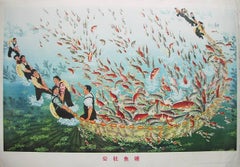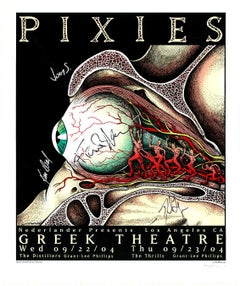Dong Zhenadao Figurative Prints
to
1
Overall Width
to
Overall Height
to
1
1
840
382
380
308
1
1
1
1
1
1
1
1
Artist: Dong Zhenadao
Fishing Pond in the Commune
By Dong Zhenadao
Located in New York, NY
Chinese Propaganda Poster. 1974
53 x 77 cm. Aprox. 21 x 30 1⁄4 inches. People's Publishing House, He Bei Province. Rare image.
Vintage Chinese Poster...
Category
1970s Modern Dong Zhenadao Figurative Prints
Materials
Screen
Related Items
Mother And Child
By Romare Bearden
Located in New York, NY
Color screenprint on paper. Signed by the artist in pencil, lower right. Numbered 71/200 in pencil, lower left.
Catalogue raisonne refernece: Gelburd/Rosenberg 59.
Framed d...
Category
1970s Modern Dong Zhenadao Figurative Prints
Materials
Screen, Color
Pixies — Original 2004 Serigraph by Emek — Hand-Signed by All Four Band Members
Located in Spokane, WA
Pixies — Original 2004 Greek Theatre LA Serigraph by Emek — Hand-Signed by All Four Members — Rare. Signed by the artist Emek as well.
Capture a key moment in alt-rock history with...
Category
Early 2000s Modern Dong Zhenadao Figurative Prints
Materials
Screen
$900
H 28.5 in W 24 in D 0.3 in
Note D, silkscreen by renowned Russian-American Jewish dissident artist Signed/N
By Grisha Bruskin
Located in New York, NY
Grisha Bruskin
Note D, 1991
Color silkscreen on Somerset paper
34 × 27 inches
Edition 74/75
Boldly signed and numbered on front in graphite pencil.
Published by Marlborough Graphics ...
Category
1980s Modern Dong Zhenadao Figurative Prints
Materials
Screen
Original Continental Airlines limited edition Serigraph vintage travel poster
Located in Spokane, WA
Original Continental Airlines travel poster. Linen backed in fine condition. Signed and numbered 35/50.
This original Continental Airlines poster is an artistic representation of regional destinations prominently served by Continental Airlines in the past. The design is modern and bold, showcasing a unique black-and-white theme with strong, futuristic typography and graphical illustrations. Each city is creatively depicted using stylized imagery that resonates with its character—Oklahoma City features a cowboy motif, New Orleans embraces a jazzy, cultural essence, Dallas reflects the energy of movement, and Midland/Odessa highlights industrial and oil-centric themes.
This limited-edition poster is printed in black and white. It features the destinations of Hawaii, San Francisco, Albuquerque and Portland Above each name is a design that represents each destination city.
Hawaii has rows of palm trees and hula dancers. San Francisco has rolling hills and cable cars. Albuquerque has tribal Indians dancing. Portland has the cruise shipping. This image features the Saul Bass l967 Continental logo in the design.
Continental Airlines was a major United States airline founded in 1934 and eventually headquartered in Houston, Texas.
The airline was acquired by UAL Corporation, the parent company of United Airlines, on October 1, 2010.
This is an original vintage Continental Airlines poster...
Category
Late 20th Century American Modern Dong Zhenadao Figurative Prints
Materials
Screen
$675
H 40 in W 26.5 in D 0.3 in
"Balcony" 1938 WPA Print Mid 20th Century American Broadway Theatre Modernism
By Leon Bibel
Located in New York, NY
"Balcony" 1938 WPA Print Mid 20th Century American Broadway Theatre Modernism.
Silk screen on paper, 15” x 20". Numbered 15/20 lower left. Pencil si...
Category
1930s American Modern Dong Zhenadao Figurative Prints
Materials
Paper, Screen
The Boundaries Of Our Realities Are Set By The Limits Of Our Imagination
By The Connor Brothers
Located in New York, NY
A pristine color screenprint, acrylic and oil paint and varnish over giclée on paper. Signed and dated in white ink by the Connor Brothers. Dimensions with the frame are 32 x 22 inches.
Category
2010s Modern Dong Zhenadao Figurative Prints
Materials
Paper, Varnish, Oil, Acrylic, Color, Giclée, Screen
$6,000
H 29.25 in W 19.5 in
Original "Wagon Lits" pop art style serigraph travel by train poster
By Valerio Adami
Located in Spokane, WA
Original “Wagon Lits” serigraph poster by the artist Valerio Adami.
It was printed in France by GrafiCaza (Michel Caza), one of the finest serigraph companies on woven paper—in exce...
Category
1990s American Modern Dong Zhenadao Figurative Prints
Materials
Screen
$260 Sale Price
20% Off
H 36 in W 24 in D 0.05 in
Poet L. Strelevits portrait. 1972, paper, screen print, 69x51 cm
Located in Riga, LV
Poet L. Strelevits portait. 1972, paper, screen print, 69x51 cm
Dzidra Ezergaile (1926-2013)
Born in Riga. School years alternate with summer work in the countryside. In 1947, she b...
Category
1970s Modern Dong Zhenadao Figurative Prints
Materials
Paper, Screen
$168 Sale Price
20% Off
H 27.17 in W 20.08 in D 0.04 in
ROBY DWI ANTONO - DI RESTORAN Limited edition Contemporary Modern
By Roby Dwi Antono
Located in Madrid, Madrid
Roby Dwi Antono - Di Restoran
Date of creation: 2021
Medium: Screen print on Somerset Velvet paper
Edition: 99 + 8AP
Size: 51 x 69 cm
Condition: In perfect conditions
Di Restoran i...
Category
2010s Modern Dong Zhenadao Figurative Prints
Materials
Archival Paper, Screen
$2,051
H 20.08 in W 27.17 in
Original "Japan" vintage travel poster serigraph bicycle
Located in Spokane, WA
Original Japan serigraph travel poster. Linen backed in very find condition, ready to frame.
Japanese travel posters have a rich history and are renowned for their captivating aesthetics, often blending traditional imagery with modern elements. In the 1970s, during the height of travel poster popularity, Japanese artists created numerous designs promoting tourism within the country and to international destinations. The poster you're referring to, produced by the American Screen Printing Co. in 1972, likely aimed to capture the essence of Japanese culture and scenery while appealing to an American audience.
Pagodas are iconic structures in Japanese architecture. They are multi-tiered towers...
Category
1970s Modern Dong Zhenadao Figurative Prints
Materials
Screen
$420 Sale Price
20% Off
H 35 in W 23.5 in D 0.05 in
DAMIEN HIRST - EMPRESSES: SUIKO Limited Modern Butterflies glitter red
By Damien Hirst
Located in Madrid, Madrid
Damien Hirst - THE EMPRESSES - SUIKO
Date of creation: 2022
Medium: Laminated giclée print on aluminium composite and screen printed with glitter.
Edition number: 1191/3310 (1.657 ph...
Category
2010s Modern Dong Zhenadao Figurative Prints
Materials
Glitter, Panel, Giclée, Screen
$9,317
H 39.38 in W 39.38 in D 0.4 in
Original Les Codes de CHANEL French fashion poster
Located in Spokane, WA
Original Les Codes de CHANEL Poster – Pink Fashion Wall Art, Modern Luxury Décor, Iconic Designer Brand Print for Bedroom, Living Room, Glam Office poster. Archival linen backed in...
Category
2010s American Modern Dong Zhenadao Figurative Prints
Materials
Screen
Dong Zhenadao figurative prints for sale on 1stDibs.
Find a wide variety of authentic Dong Zhenadao figurative prints available for sale on 1stDibs. You can also browse by medium to find art by Dong Zhenadao in screen print and more. Much of the original work by this artist or collective was created during the 1970s and is mostly associated with the modern style. Not every interior allows for large Dong Zhenadao figurative prints, so small editions measuring 31 inches across are available. Customers who are interested in this artist might also find the work of Reuven Rubin, Max Ernst, and Antoni Tàpies. Dong Zhenadao figurative prints prices can differ depending upon medium, time period and other attributes. On 1stDibs, the price for these items starts at $1,800 and tops out at $1,800, while the average work can sell for $1,800.

